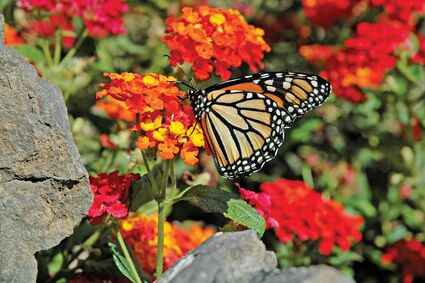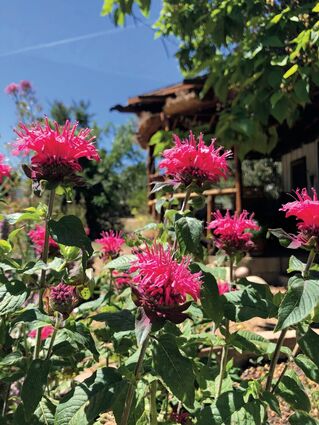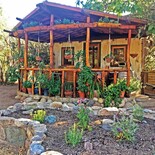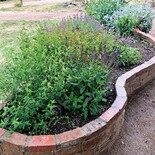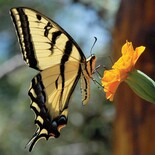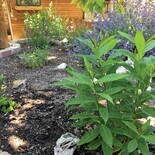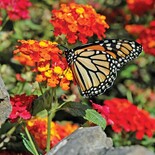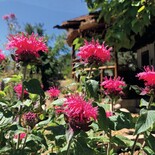Pollinator plants: gardening to attract butterflies and more
Land of Four Seasons
April 2, 2022
Would you like to make your garden or yard more interesting and colorful? Then I highly recommend planting flowers that will attract an assortment of pollinators. Not only are the blossoms themselves beautiful to look at and often fragrant, but the activity of insects can be enthralling as you watch an assortment of butterflies, hummingbirds, moths, bees and other creatures forage among your flowers.
Pollinator plants often grow well in planters or raised gardens, so they are well-suited to smaller growing areas as well as larger yards. I've incorporated pollinator plants at my own house as well as when landscaping for others, and they reliably provide beauty and delight.
Pollinator plants are commonly categorized as nectar plants or host plants. In the case of nectar plants, of course, blossoms provide sugar-rich liquid to sustain hummingbirds, adult butterflies, etc. Host plants are those whose leaves or petals provide food for caterpillars, the larvae of butterflies. In this column, I'm focusing on nectar plants rather than host plants.
One of my favorite plants is Bee Balm, (Monarda genus), a North American native that is loved by both hummingbirds and butterflies. Different species of this perennial plant have a variety of common names, including bergamot, Oswego tea, horsemint, and others. It has a cluster of little tubular flowers in a circular arrangement on large rounded flowerheads. Pollinator gardens in the Tehachapi Mountains should include some Bee Balm, which typically comes in shades of red, purple and pink.
Another reliable choice for attracting nectar-feeders is the aptly-named Butterfly Bush (Buddleia, also spelled Buddleja). These shrubs first became popular primarily with blue flowers, but now the colors range from deep purple to red, yellow and pink. There are also dwarf and semi-dwarf varieties, which are the best type for container growing, since full-size Butterfly Bush can reach six to eight feet tall if left unpruned.
In addition to their appeal for butterflies and hummingbirds, Butterfly Bush can also be recommended for the duration of their blooming – practically all summer long. While our fragrant and lovely lilacs are a joy in early spring, their flowering only lasts for a few weeks, while Butterfly Bush just keeps blooming and blooming.

Many butterflies like flat-topped flowerheads so it is easier for them to walk on them and navigate as they collect nectar. For that reason, assorted yarrow plants are popular with butterflies, as are asters, coreopsis, coneflowers, sunflowers, cosmos and others with large, stable flowers.
They are many choices of penstemon, with their trumpet-shaped flowers, that also attract hummingbirds as well as butterflies and other pollinators. Penstemons are also known as beardtongues, and there are many species and countless varieties – beardtongues are considered to be the largest genus of flowering plants endemic to North America.
Many of the familiar herbs that are grown for culinary, cosmetic or medicinal purposes are also appealing to pollinators. Rosemary, lavenders, and sages (Salvia) of all kinds have pretty flowers that are attractive to nectar-feeders. The leaves of herbs also tend to be strongly flavored or resinous, which discourages browsing by deer, which is added plus in the outlying areas of the Tehachapi Mountains where California Mule Deer happily treat gardens as a salad bar.
Lamb's Ear is a delightful traditional herb that has soft, velvety leaves that are indeed reminiscent of the ears of a newborn lamb. With its plush gray-green leaves and tiny blue flowers, Lamb's Ear is another welcome addition to a pollinator garden.
Milkweeds of various kinds (Ascelpias) are welcomed by assorted pollinators, and are the only host plant used by the distinctive striped caterpillars of Monarch butterflies. Marigolds are also appealing to butterflies, and they of course do well in containers or hanging flower pots.
Mountain Garden Nursery on the corner of Curry Street and C Street has many great pollinator plants, both California natives and assorted cultivars, and is a good place to start when assembling plants to make your yard more welcoming to pollinators. JDB Nursery in Cummings Valley is more known for their trees and shrubs, but it's a wonderful local nursery and they also have flowers during the warmer months.
Having hummingbirds, butterflies and other pollinators busily visiting your flowers is one of the joys of the outdoors and the gardening life. Many pollinator-friendly plants are hardy and fairly low-maintenance, and they give more than they take.
Watching a graceful Western Tiger Swallowtail, Painted Lady, Monarch or Admiral butterfly, riding a gentle Tehachapi breeze to come forage among the colorful flowers in your garden, is an experience worth having. . .and worth planting for.
Keep enjoying the beauty of life in the Tehachapi Mountains.
Jon Hammond is a fourth generation Kern County resident who has photographed and written about the Tehachapi Mountains for 38 years. He lives on a farm his family started in 1921, and is a speaker of Nuwä, the Tehachapi Indian language. He can be reached at tehachapimtnlover@gmail.com.


